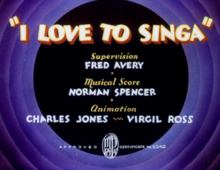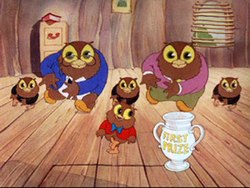I Love to Singa
| I Love to Singa | |
|---|---|
 | |
| Directed by | Fred Avery |
| Produced by | Leon Schlesinger |
| Music by | Norman Spencer |
| Animation by | Charles Jones Virgil Ross |
| Color process | Technicolor |
Production company | |
| Distributed by | Warner Bros. Pictures The Vitaphone Corporation |
Release dates |
|
Running time | 8:14 |
| Language | English |
I Love to Singa is a 1936 Warner Bros. Merrie Melodies animated cartoon directed by Tex Avery.[1] The short was released on July 18, 1936.[2]
Plot
[edit]
I Love to Singa depicts the story of an owlet (singing voice of Jackie Morrow, speaking voice of Tommy Bond) who wants to sing jazz, instead of the classical music that his German-accented parents wish him to perform. The plot is a tribute to Al Jolson's 1927 film The Jazz Singer.[3]
The owlet's disciplinarian violinist father, Professor Fritz Owl (voiced by Billy Bletcher), kicks him out of the family's home after catching him singing jazz instead of "Drink to Me Only with Thine Eyes" to the pump organ accompaniment of his mother (voiced by Martha Wentworth). While wandering, he encounters a radio amateur contest (clearly a takeoff of the Major Bowes Amateur Hour), hosted by "Jack Bunny" (a pun on Jack Benny and later used in Goofy Groceries, voiced by Tedd Pierce). Billing himself as "Owl Jolson" (a reference to Al Jolson), he performs and his family, worried sick about him (including his father Fritz, who now regrets throwing his son out) hears him over the radio. They rush to the station.
Jack Bunny has decided Owl Jolson wins First Prize, but when the owlet sees his family watching him from outside the studio, he reverts to singing "Drink to Me Only with Thine Eyes". Jack Bunny is about to revoke the prize, but the family bursts through the studio and stops Jack Bunny from kicking their owlet out of the studio. And so, Professor Fritz, having finally realized both his errors and his son's true potential, allows him to freely sing jazz. Jack Bunny then gives Owl Jolson the prize, and so on the owl family lived happily ever after.
Reception
[edit]As with several early Warners cartoons, it is in a sense a music video designed to push a song from the Warners library. The song in question, "I Love to Singa", was first written by Harold Arlen and E.Y. Harburg for the 1936 Warner Bros. feature-length film The Singing Kid. It is performed three times in the film: first by Al Jolson and Cab Calloway, then by the Yacht Club Boys and Jolson, and finally again by Calloway and Jolson. During this period, it was customary for Warners to have their animation production partner, Leon Schlesinger Productions, make Merrie Melodies cartoons based upon songs from their features.
The cartoon has become a cult favorite, with a pervasive impact on popular culture. The short, one of the earliest Merrie Melodies produced in Technicolor's three-color process, is recognized as one of Avery's early masterpieces. Musicologist Daniel Goldmark writes, "I Love to Singa may be one of the most instantly endearing cartoons Warner Bros. ever created. The story combines two themes that are as popular then as they are now—a child breaking away from his parents and contesting chasing the 'rags-to-riches' promise of amateur shows."[4] Animation historian Jerry Beck agrees, "While not as wacky as Tex Avery's later works, I Love to Singa is still the perfect metaphor for the changes this great director brought to the studio. Instead of following stuffy cartoon convention, Tex taught his peers to march to their own drummers."[4]
Legacy
[edit]The May 7, 2013 episode of The Looney Tunes Show, "Gribbler's Quest", featured a Merrie Melodies segment in which Gossamer plays the piano and sings "I Love to Singa" (with new audio sung by Kwesi Boakye). This was one of two instances of the show's Merrie Melodies segment using a classic song rather than a new composition with the other instance being "Yellow Bird". However, the lyrics were changed to remove racist terms such as "mammy."
In the first episode of the American animated television series South Park, "Cartman Gets an Anal Probe", Cartman and Officer Barbrady are hit by an alien beam, causing them to begin singing and dancing to "I Love to Singa".
Owl Jolson appears in several levels of the video game Looney Tunes: Back in Action, singing "I Love to Singa" via archive audio. Bugs Bunny and Daffy Duck will comment upon Owl when they get close enough.
As a short published in 1936 with its copyright renewed, the short will enter the public domain on January 1, 2032.[5]
Home media
[edit]- VHS – Cartoon Moviestars Porky!
- LaserDisc – Cartoon Moviestars Daffy and Porky!
- VHS – The Golden Age of Looney Tunes
- LaserDisc – The Golden Age of Looney Tunes
- DVD – Happy Feet
- DVD – Looney Tunes Golden Collection: Volume 2
- Blu-ray/DVD – Looney Tunes Platinum Collection: Volume 1
- Blu-ray/DVD – The Jazz Singer
References
[edit]- ^ Beck, Jerry; Friedwald, Will (1989). Looney Tunes and Merrie Melodies: A Complete Illustrated Guide to the Warner Bros. Cartoons. Henry Holt and Co. p. 47. ISBN 0-8050-0894-2.
- ^ Lenburg, Jeff (1999). The Encyclopedia of Animated Cartoons. Checkmark Books. pp. 104–106. ISBN 0-8160-3831-7. Retrieved 6 June 2020.
- ^ Schneider, Steve (1988). That's All, Folks! : The Art of Warner Bros. Animation. Henry Holt and Co. p. 49. ISBN 0-8050-0889-6.
- ^ a b Beck, Jerry, ed. (2020). The 100 Greatest Looney Tunes Cartoons. Insight Editions. p. 107. ISBN 978-1-64722-137-9.
- ^ "R330989 in the Catalog of Copyright Entries". U.S. Govt. Print. Off. 1964.
External links
[edit]- I Love to Singa at IMDb
- I Love To Singa (1936) on the Internet Archive
- I Love to Singa on YouTube
- 1936 films
- 1936 songs
- 1936 short films
- 1930s color films
- 1936 animated films
- 1930s American animated films
- 1930s Warner Bros. animated short films
- American comedy short films
- Films scored by Norman Spencer (composer)
- Films directed by Tex Avery
- Merrie Melodies short films
- Animated films about owls
- 1930s English-language films
- American animated short films
- American musical comedy films
- 1939 musical comedy films
- The Jazz Singer (play)
- English-language comedy short films
- English-language musical comedy films
